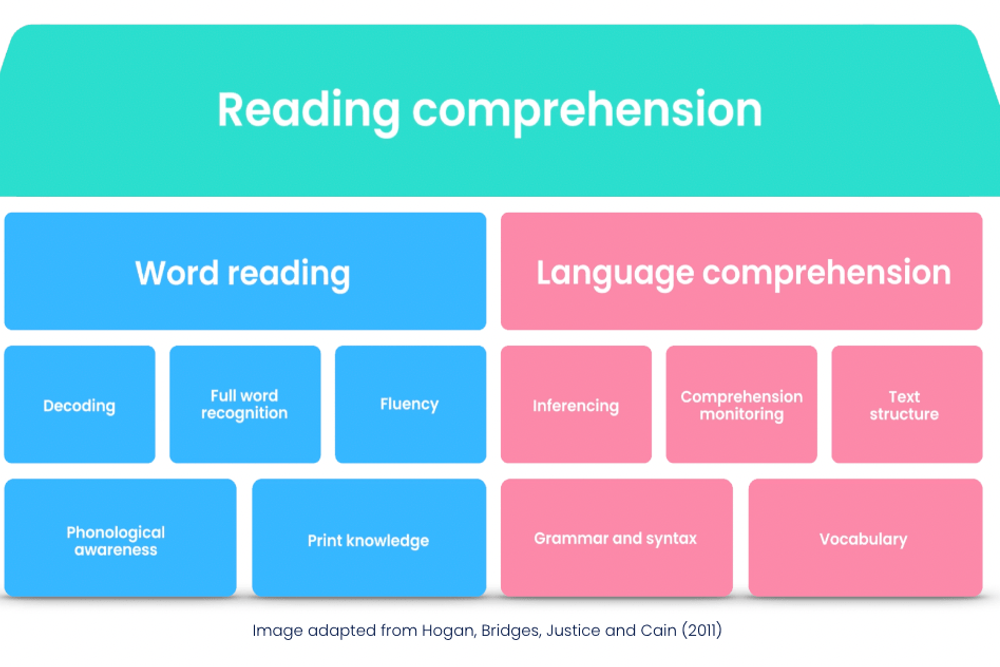This means that when one aspect of reading is strong and well-practised, the other feels the benefits too; it also means that when one aspect is weaker, so is the other, and this can limit learners from achieving their potential.
Some believe that reading comprehension is a skill that occurs by chance when learners read. However, to give every learner the best opportunity for success, we cannot rely on chance for their education – reading comprehension skills must be tackled intentionally and consistently.
If this is something you need to focus on in your classroom, find our tips and strategies for boosting reading comprehension amongst learners and improving literacy development through reading.
What is reading comprehension?
Reading comprehension refers to the ability to understand and remember the information in a text. This is a vital skill in education and it has been found that improving reading comprehension can be difficult for those who struggle with reading.
Reading more has been shown to improve reading comprehension – but how can we expect a learner to enjoy reading when they cannot understand the words in the text?
If you had to explain what it was about reading a book that you enjoyed, you would likely say the plot, the speech, the characters, or the immersion of the writing. Without reading comprehension, there’s no way to enjoy any of these features, so why would you read?
Low reading comprehension therefore can’t be solved by simply encouraging learners to read. It requires dedicated strategies to improve understanding and boost learners’ literacy.
Strategies for improving reading comprehension
There are many tried and tested strategies for improving reading comprehension available to teachers. Depending on whether you are a teacher, librarian or guardian, different strategies will benefit your learners. As well as this, the outcome of certain strategies will deliver different benefits depending on your use of edtech in the classroom and your school’s implementation of whole-school literacy.
Due to this, we have collated blogs with information and free resources for you to use at your school so that you can find the reading comprehension strategy that works best for your learners.
Explore our blogs discussing strategies you can use to improve reading comprehension for your learners:
This blog provides a comprehensive overview of reading comprehension strategies in the classroom, explaining what reading comprehension is, the benefits reading comprehension has on your learners’ progress, and multiple strategies you can utilise in your classroom to boost your reading comprehension instruction.
We also provide free resources and templates for these strategies so you can save time beginning your literacy journey.
Reading comprehension improvement matters just as much at home as it does at school. To encourage learners and parents to focus on reading comprehension at home, we have created 15 reading comprehension activities for children.
Teachers can use this booklet of reading comprehension resources to encourage parents to continue reading comprehension instruction at home, or parents can access these resources for free to work through at home at their child’s own pace.
Linking to the last blog, this blog highlights the importance of focusing on reading and reading comprehension at home as well as within school. Many of the benefits of strong reading comprehension skills come after learners have left the classroom and begun their adult lives, such as consuming media, reading the news, understanding bias, improving their critical literacy, and even getting and succeeding at their job.
Improving your child’s reading at home has the potential to unlock success throughout their life, in every subject and every area.
Improving reading comprehension for students with special educational needs
Improving reading comprehension cannot be achieved the same way for every learner – this is especially true when teaching learners with special educational needs. That’s why we have explored specific strategies for learners with special educational needs. In it, we explore the unique challenges learners face with different educational needs, such as ADHD, dyslexia, autism spectrum disorder and visual processing disorders. We explore how different intervention strategies can provide unique benefits for learners with additional educational needs.
Improving reading comprehension for EAL students
Teaching reading comprehension skills to learners who speak English as an additional language requires unique strategies. Unlike other learners, EAL learners approach reading comprehension with another language as context, likely a language they have more proficiency in than English.
Don’t ignore their proficiency in other languages. Instead, use their skills in foreign languages to boost their reading comprehension skills in English, even if that means allowing them to think, speak and write in an alternative language.
Read more about translanguaging and semantic maps, and how they can support reading comprehension.
To find more reading comprehension strategies specific to EAL learners, read our article on reading comprehension for EAL students.
Inference and reading comprehension
Reading comprehension is more than just about understanding what is happening in a text – it is about reading between the lines. Learners not only have to be able to read what the text is saying but what the text is not, which can be even more complicated.
To tackle this, find our blog on the importance of inference in reading comprehension, and strategies you can use to combat this in your reading comprehension instruction. You can also find details on how you can specifically teach inference skills in our blog on teaching inference skills.
Vocabulary and reading instruction
Learners need to understand over 90% of the vocabulary in a text to comprehend its meaning. For learners with a limited vocabulary, this means that explicit vocabulary instruction is necessary for boosting reading comprehension.
Grammar and reading comprehension
Not only do learners have to understand the words in a text, but also how the author has linked them together. Understanding why sentences are constructed in certain ways, the capitalisation of proper nouns, and even the positioning of commas in a sentence, can have a significant impact on a learner’s ability to comprehend the text. Strong reading comprehension skills need a strong understanding of grammar.
Why we believe reading comprehension is one of the foundations of literacy
Reading comprehension encompasses every aspect of literacy, from learning vocabulary, decoding words and reading fluently, to understanding the language you are reading through inference and grammatical knowledge. This, in turn, allows learners to communicate effectively and improve their educational attainment.

English is the language of learning across the curriculum. Throughout academia and our adult lives, books and text remain some of the most common ways we acquire new information - to prepare learners to receive knowledge in this way, the foundations of reading comprehension should be explicitly taught for mastery. This can be a daunting task when reading involves so many intertwining factors - every learner in your class may struggle with a different aspect.
That’s why a digital literacy curriculum helps teachers prioritise reading comprehension in every subject.
Bedrock’s vocabulary curriculum teaches learners the Tier 2 vocabulary they need for complex academic texts, forming that “vocabulary” block of reading comprehension. Bedrock’s accessible, intelligent Block system ensures every learner in your class receives reading activities personalised to their ability with the right balance between challenge and accessibility.
As well as this, Bedrock’s core curriculum includes a foundational and advanced grammar curriculum, differentiated for primary and secondary learners. This curriculum explicitly teaches grammar skills through engaging teaching videos and mastery tasks, ensuring learners have the key knowledge of grammar skills they need to comprehend texts they encounter in the classroom.





